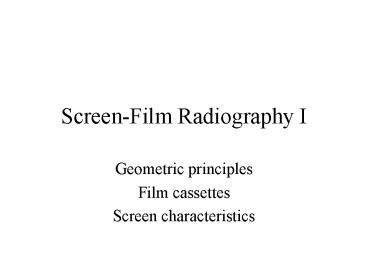ScreenFilm Radiography I - PowerPoint PPT Presentation
1 / 29
Title:
ScreenFilm Radiography I
Description:
Screen-Film Radiography I. Geometric principles. Film cassettes. Screen characteristics ... Projection imaging refers to the acquisition of a two-dimensional ... – PowerPoint PPT presentation
Number of Views:253
Avg rating:3.0/5.0
Title: ScreenFilm Radiography I
1
Screen-Film Radiography I
- Geometric principles
- Film cassettes
- Screen characteristics
2
Projection radiography
- Projection imaging refers to the acquisition of a
two-dimensional image of the patients
three-dimensional anatomy - Radiography is a transmission imaging procedure
- In screen-film radiography, the optical density
(OD) at a specific location on the film is
(ideally) determined by the x-ray attenuation
characteristics of the patients anatomy along a
straight line through the patient between the
x-ray source and the corresponding location on
the detector
3
(No Transcript)
4
Basic geometric principles
- Two triangles that have the same shape (the three
angles of one are equal to the three angles of
the other) but have different sizes are said to
be similar triangles - If two triangles are similar, the ratio of the
corresponding sides and heights are equal - Similar triangles are encountered when
determining image magnification and when
evaluating image unsharpness
5
(No Transcript)
6
Magnification
- Magnification occurs because the beam diverges
from the focal spot to the image plane - Magnification given by
- Largest when object close to focal spot
7
(No Transcript)
8
Extended source
- With magnification, geometric blurring of the
object occurs in the image - Similar triangles allow calculation of the edge
gradient blurring, f, in terms of magnification,
M, and focal spot size, F
9
Extended source (cont.)
- Blur increases with the size of the focal spot
and with the amount of magnification - Focal spot blur can be minimized by keeping the
object close to the image plane
10
(No Transcript)
11
Screens
- Film by itself can be used to detect x-rays
- Relatively insensitive
- A lot of x-ray energy is required to produce a
properly exposed x-ray film - X-ray screens are used to reduce the x-ray dose
to the patient - Screens are made of a scintillating material,
called a phosphor - X-rays interact in the phosphor visible or
ultraviolet light is emitted
12
Materials
- For much of the 20th century, calcium tungstate
(CaWO4) most commonly used - In early 70s, rare earth phosphors introduced
- Most common used today is gadolinium oxysulfide
(Gd2O2S) - Others are lanthanum oxybromide (LaOBr) and
yttrium tantalate (YTaO4) - Cesium iodide (CsI) is used in fluroscopy and
digital radiography too moisture sensitive and
fragile for use in screen-film radiography
13
(No Transcript)
14
Phosphor thickness
- Usually expressed as the mass thickness (product
of thickness and density) of the phosphor,
excluding the binder - For general radiography, two screens are used,
with each screen having a thickness of about 60
mg/cm2, for a total thickness of 120 mg/cm2 - For high-resolution requirements and low energies
used in mammography, a single screen of
approximately 35 mg/cm2 is used
15
Screen function
- Screen function is two-fold
- Absorbing (detecting) incident x-rays
- Emitting visible (or UV) light, which exposes the
film - Conversion efficiency defined as the fraction of
the absorbed energy that is emitted as light - CaWO4 about 5
- Gd2O2STb about 15
- Not all emitted photons reach the film emulsion
after diffusing through the phosphor and being
reflected at interface layers
16
Quantum detection efficiency
- QDE of a screen is defined as the fraction of
incident x-ray photons that interact with it - Easiest way to increase QDE is to make the screen
thicker
17
(No Transcript)
18
Thickness effects
- After an x-ray absorption event, visible light
given off in the depth of a screen propagates
towards the screens surface to reach the
adjacent film emulsion layer - Spreads out in all directions with equal
probability (isotropic diffusion) - For thicker screens, light photons propagate
greater lateral distances
19
(No Transcript)
20
Resolution
- Increasing the screens thickness increases
detection efficiency and thereby improves the
screens sensitivity - Increased thickness causes undesirable loss of
spatial resolution - Classic compromise between sensitivity and
resolution seen in many imaging systems - Modulation transfer function (MTF) is the
technical description of spatial resolution for
most imaging systems
21
(No Transcript)
22
Conversion efficiency
- Total conversion efficiency of a screen-film
combination refers to the ability of the screen
or screens to convert the energy deposited by
absorbed x-rays into film darkening - Depends on intrinsic conversion efficiency of the
phosphor, efficiency of light propagation through
screen to emulsion layer, and efficiency of film
emulsion in absorbing the emitted light - Light-absorbing dye may be used to reduce light
propagation distance and preserve spatial
resolution
23
(No Transcript)
24
Conversion efficiency (cont.)
- For faster (i.e., higher conversion efficiency),
lower-resolution screen-film system, a reflective
layer can be placed between the screen and its
support - Intensifying screen by itself is a linear device
at a given x-ray energy - If number of x-ray photons is doubled, light
intensity produced by screen also doubles
25
(No Transcript)
26
(No Transcript)
27
Overall efficiency
- Total efficiency of a screen-film system is the
product of the conversion efficiency and the
absorption efficiency - Screen-film system provides vast increase in
x-ray detection efficiency over film by itself - At 80 kVp, a 120 mg/cm2 thickness of Gd2O2S
detects 29.5 of the incident x-ray energy - Film detects only 0.65 of the incident x-ray
energy
28
(No Transcript)
29
Other benefits
- Output requirements of the x-ray system are
reduced, substantially reducing the requirement
for powerful generators and high heat capacity
tubes and reducing costs - Exposure times are shorter and motion artifacts
are reduced - Exposure to personnel from scattered x-rays is
reduced































